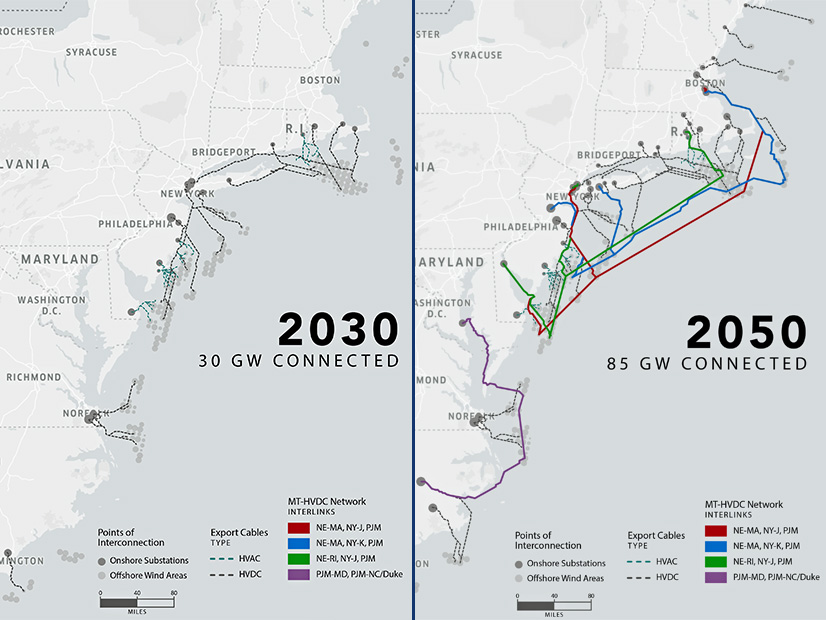
Federal regulators on Tuesday issued a suggested road map for building out the transmission network needed for the thousands of wind turbines envisioned off the Northeast coast.
The departments of Energy and Interior presented “An Action Plan for Offshore Wind Transmission Development in the U.S. Atlantic Region” as a tool to boost the offshore wind sector, strengthen the domestic supply chain and create jobs while protecting the climate.
It suggests immediate actions to connect the first generation of wind projects to the onshore grid and longer-term efforts to continue growing the new energy sector for decades to come.
The Biden administration has set a goal of 30 GW of installed offshore wind generation by 2030. Subsequent federal goals and the individual goals of numerous states could push the total above 100 GW by 2050.
The Action Plan was shaped by a series of workshops with experts and stakeholders from early 2022 to early 2023 and by the forthcoming Atlantic Offshore Wind Transmission Study by DOE’s Wind Energy Technologies Office.
The Action Plan identifies increased intra-regional coordination, shared transmission lines and a network of offshore HVDC interlinks as priorities. To accomplish this, it makes a series of recommendations for industry; local, state and federal governments; and other stakeholders.
These include:
-
- Before 2025: Establish collaborative bodies; identify steps to be taken, such as updating reliability standards and offshore-onshore interconnection points; create voluntary cost assignments and tax credits.
- From 2025 to 2030: Convene and coordinate with states to plan an offshore transmission network; with industry to standardize HVDC technology requirements; and with tribes, state agencies, stakeholders and federal agencies on priority transmission paths.
- From 2030 to 2040: Establish a national HVDC testing and certification center to ensure compatibility in the offshore grid network that is envisioned.
Offshore wind is one of President Biden’s signature initiatives, but it faced significant challenges even before the financial and supply-chain hurdles that began to threaten progress in 2022.
Central among these challenges, the Action Plan states, is that there is no offshore grid.
A disparate collection of stakeholders with competing interests must create an expensive new piece of infrastructure that can carry large amounts of electricity long distances in a harsh environment using facilities that do not yet exist with equipment and components that are in short supply.
They must navigate multiple regulatory processes in each of as many as four levels of review — local, state, federal and tribal — while protecting the marine environment, respecting coastal communities and minimizing conflict with other ocean users.
They must connect to an onshore distribution grid that already is vastly oversubscribed and is not standardized between regions.
Networked transmission might help with this, but such interregional efforts carry their own set of planning, ownership and cost allocation challenges.
Coordinated transmission is “notoriously difficult” to develop.
All of this demonstrates the urgent need for proactive and coordinated transmission planning along the Northeast U.S. coast, the Action Plan asserts. It identifies several specific shorter- and longer-term obstacles:
-
- Near-term: Without a long-term planning vision, early projects using radial transmission lines could preclude future holistic transmission solutions; significant onshore upgrades will be needed to deliver the electricity coming off the ocean; siting is complex.
- Mid- and long-term: Offshore transmission costs are high, and cost allocation mechanisms are inadequate; developing new policies, standards and practices may delay projects; strategic planning must replace unsustainable current interconnection practices; separation of generation and transmission creates a risk that one becomes a stranded asset while the other is being completed.
Spiraling costs have become an issue with offshore wind, as inflation and interest rates drive up development expenses that ultimately will be borne by the American public, whether through utility rates or taxes or consumer costs.
The price tag of the envisioned interstate offshore grid is unknown, but the Action Plan cites a telling estimate in a report completed by the Brattle Group on behalf of several environmental advocacy and clean energy industry groups: Proactive transmission planning for a future 100 GW offshore wind industry would save at least $20 billion.
A leading offshore wind industry group applauded release of the action plan Tuesday and highlighted the difficulty of the present-day development process.
“Rebuilding our transmission system is extremely complex, and the federal government can play a unique role bringing major parties together to break through barriers,” said Liz Burdock, CEO of the Business Network for Offshore Wind.
“Along with ensuring that we can develop our industry, building out the grid in a coordinated fashion will yield enormous benefits for ratepayers and the environment, build confidence in the market’s trajectory and accelerate development. We welcome the release of this action plan and encourage the federal government to begin working to bring states and stakeholders together.”

